SUBARU BRZ 2017 1.G Owners Manual
Manufacturer: SUBARU, Model Year: 2017, Model line: BRZ, Model: SUBARU BRZ 2017 1.GPages: 540, PDF Size: 6.88 MB
Page 261 of 540
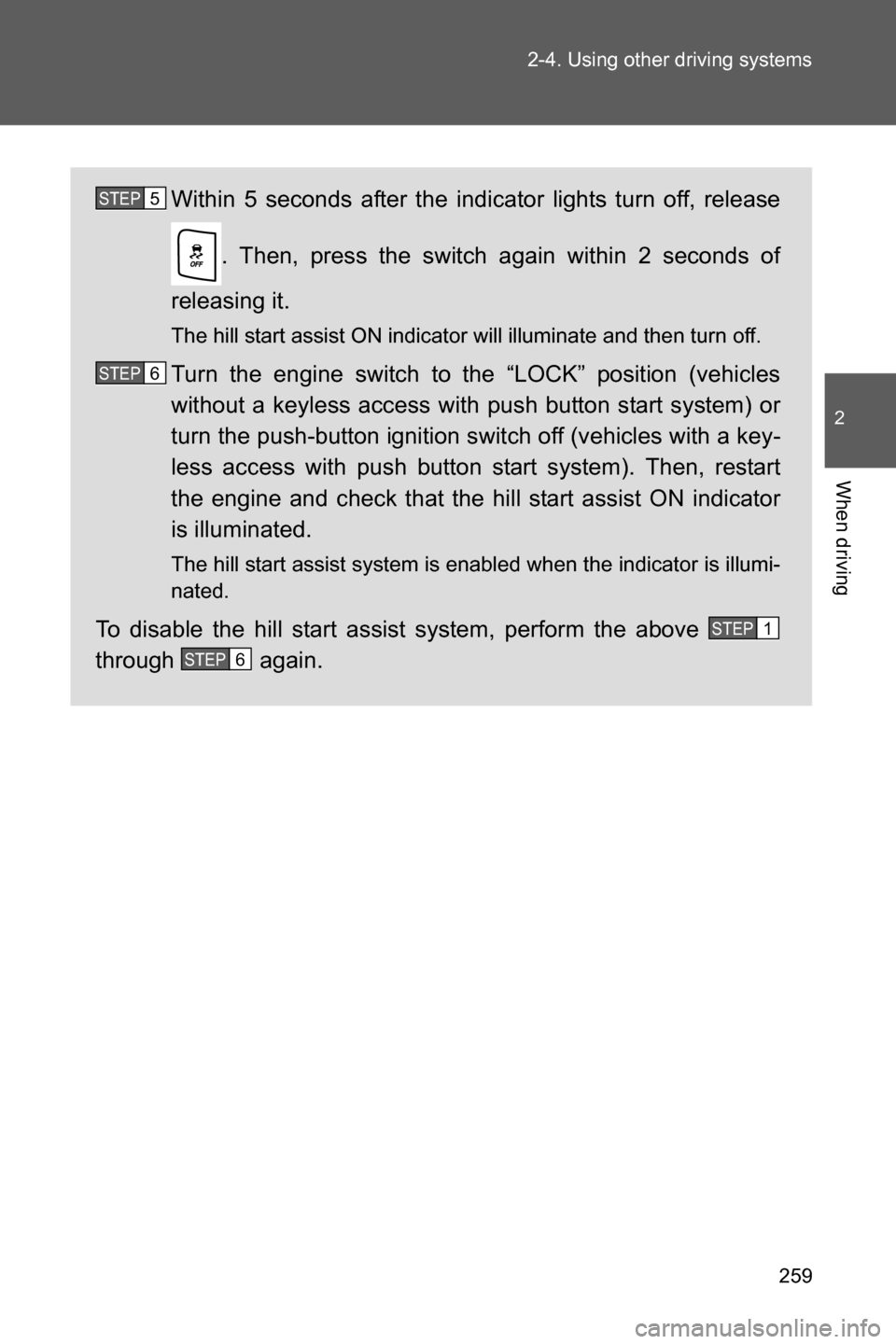
259 2-4. Using other driving systems
2
When driving
Within 5 seconds after the indicator lights turn off, release
. Then, press the switch again within 2 seconds of
releasing it.
The hill start assist ON indicator will illuminate and then turn off.
Turn the engine switch to the “LOCK” position (vehicles
without a keyless access with push button start system) or
turn the push-button ignition switch off (vehicles with a key-
less access with push button start system). Then, restart
the engine and check that the hill start assist ON indicator
is illuminated.
The hill start assist system is enabled when the indicator is illumi-
nated.
To disable the hill start assist system, perform the above
through again.
STEP 5
STEP 6
STEP 1
STEP 6
Page 262 of 540
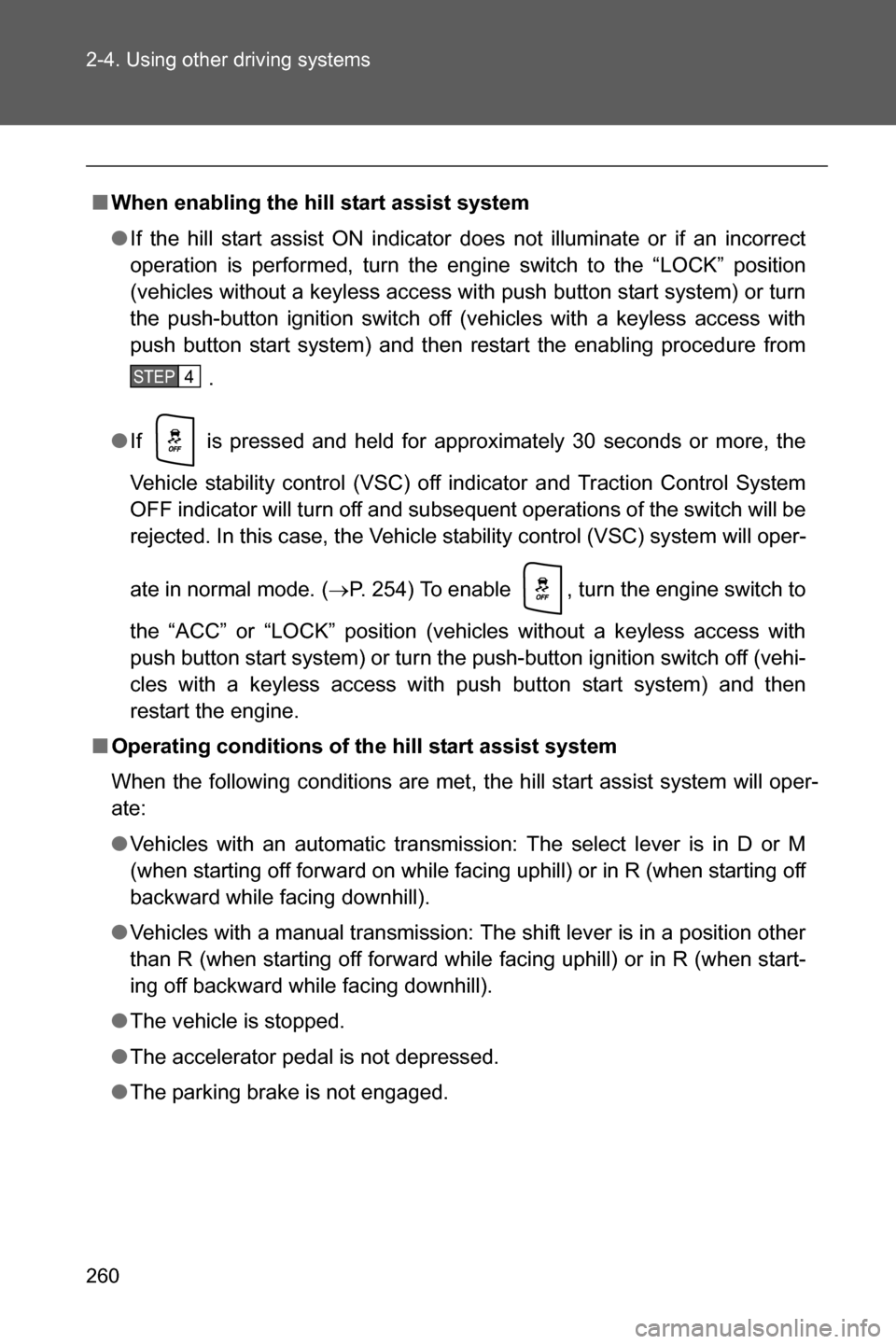
260 2-4. Using other driving systems
■When enabling the hill start assist system
●If the hill start assist ON indicator does not illuminate or if an incorrect
operation is performed, turn the engine switch to the “LOCK” position
(vehicles without a keyless access with push button start system) or turn
the push-button ignition switch off (vehicles with a keyless access with
push button start system) and then restart the enabling procedure from
.
●If is pressed and held for approximately 30 seconds or more, the
Vehicle stability control (VSC) off indicator and Traction Control System
OFF indicator will turn off and subsequent operations of the switch will be
rejected. In this case, the Vehicle stability control (VSC) system will oper-
ate in normal mode. (�oP. 254) To enable , turn the engine switch to
the “ACC” or “LOCK” position (vehicles without a keyless access with
push button start system) or turn the push-button ignition switch off (vehi-
cles with a keyless access with push button start system) and then
restart the engine.
■Operating conditions of the hill start assist system
When the following conditions are met, the hill start assist system will oper-
ate:
●Vehicles with an automatic transmission: The select lever is in D or M
(when starting off forward on while facing uphill) or in R (when starting off
backward while facing downhill).
●Vehicles with a manual transmission: The shift lever is in a position other
than R (when starting off forward while facing uphill) or in R (when start-
ing off backward while facing downhill).
●The vehicle is stopped.
●The accelerator pedal is not depressed.
●The parking brake is not engaged.
STEP 4
Page 263 of 540

261 2-4. Using other driving systems
2
When driving
■The hill start assist system will not operate when
The hill start assist system will not operate when any of the following condi-
tions are met:
●Vehicles with an automatic transmission: The select lever is in a position
other than D or M (when facing uphill) or in a position other than R (when
facing downhill).
●Vehicles with a manual transmission: The shift lever is in R (when facing
uphill) or in a position other than R (when facing downhill).
●Vehicles with an automatic transmission: The accelerator pedal is
depressed.
●The parking brake is applied.
●Vehicles with a manual transmission: The clutch is engaged.
●Approximately 2 seconds have elapsed since the brake pedal was
released.
●The hill start assist ON indicator is not illuminated.
●Vehicles without a keyless access with push button start system: The
engine switch is turned to the “ACC” or “LOCK” position.
●Vehicles with a keyless access with push button start system: The push-
button ignition switch is turned to “ACC” mode or turned off.
■Notes for the hill start assist system
●A slight jolt may be felt when starting off backward with the select lever in
R (vehicles with an automatic transmission) or the shift lever in R (vehi-
cles with a manual transmission) and then moving forward.
●If the braking power of the hill start assist system is insufficient, depress
the brake pedal.
●While the vehicle is stopped, make sure to depress the brake pedal.
■The system may be malfunctioning when
In the following situations, the system may be malfunctioning. Have the vehi-
cle inspected by your SUBARU dealer.
●The slip indicator is illuminated.
●The hill start assist ON indicator turns off and a buzzer sounds.
Page 264 of 540

262 2-4. Using other driving systems
WARNING
■Hill start assist system precautions
●Do not overly rely on the hill start assist system. The hill start assist system
may not operate effectively on steep inclines and roads covered with ice.
●Unlike the parking brake, the hill start assist system is not intended to hold
the vehicle stationary for an extended period of time. Do not attempt to use
the hill start assist system to hold the vehicle on an incline, as doing so
may lead to an accident.
●Do not stop the engine while the hill start assist system is operating, as the
hill start assist system will stop operating, possibly leading to an accident.
Page 265 of 540
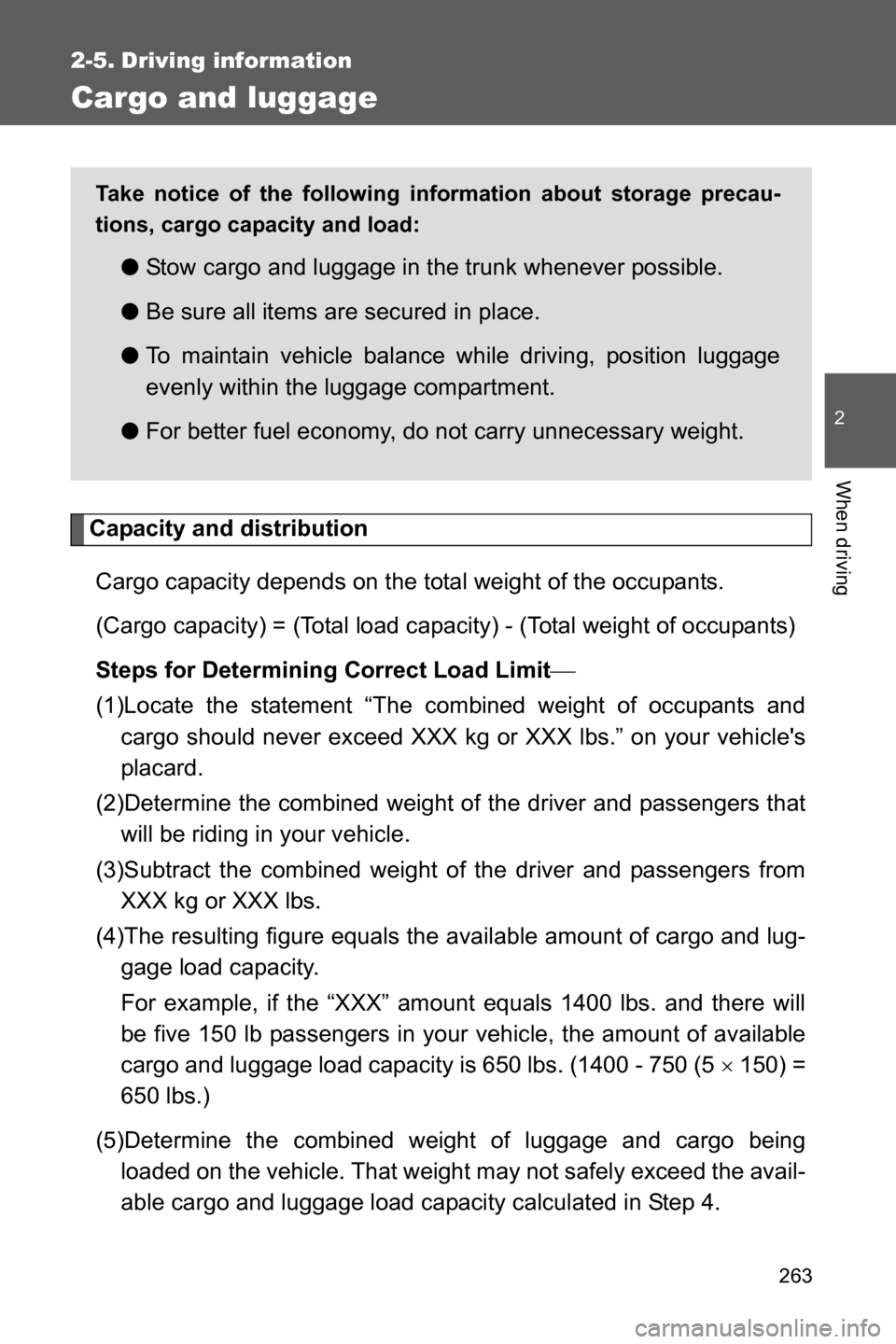
263
2
When driving
2-5. Driving information
Cargo and luggage
Capacity and distribution
Cargo capacity depends on the total weight of the occupants.
(Cargo capacity) = (Total load capacity) - (Total weight of occupants)
Steps for Determining Correct Load Limit�
(1)Locate the statement “The combined weight of occupants and
cargo should never exceed XXX kg or XXX lbs.” on your vehicle's
placard.
(2)Determine the combined weight of the driver and passengers that
will be riding in your vehicle.
(3)Subtract the combined weight of the driver and passengers from
XXX kg or XXX lbs.
(4)The resulting figure equals the available amount of cargo and lug-
gage load capacity.
For example, if the “XXX” amount equals 1400 lbs. and there will
be five 150 lb passengers in your vehicle, the amount of available
cargo and luggage load capacity is 650 lbs. (1400 - 750 (5 �u 150) =
650 lbs.)
(5)Determine the combined weight of luggage and cargo being
loaded on the vehicle. That weight may not safely exceed the avail-
able cargo and luggage load capacity calculated in Step 4.
Take notice of the following information about storage precau-
tions, cargo capacity and load:
●Stow cargo and luggage in the trunk whenever possible.
●Be sure all items are secured in place.
●To maintain vehicle balance while driving, position luggage
evenly within the luggage compartment.
●For better fuel economy, do not carry unnecessary weight.
Page 266 of 540
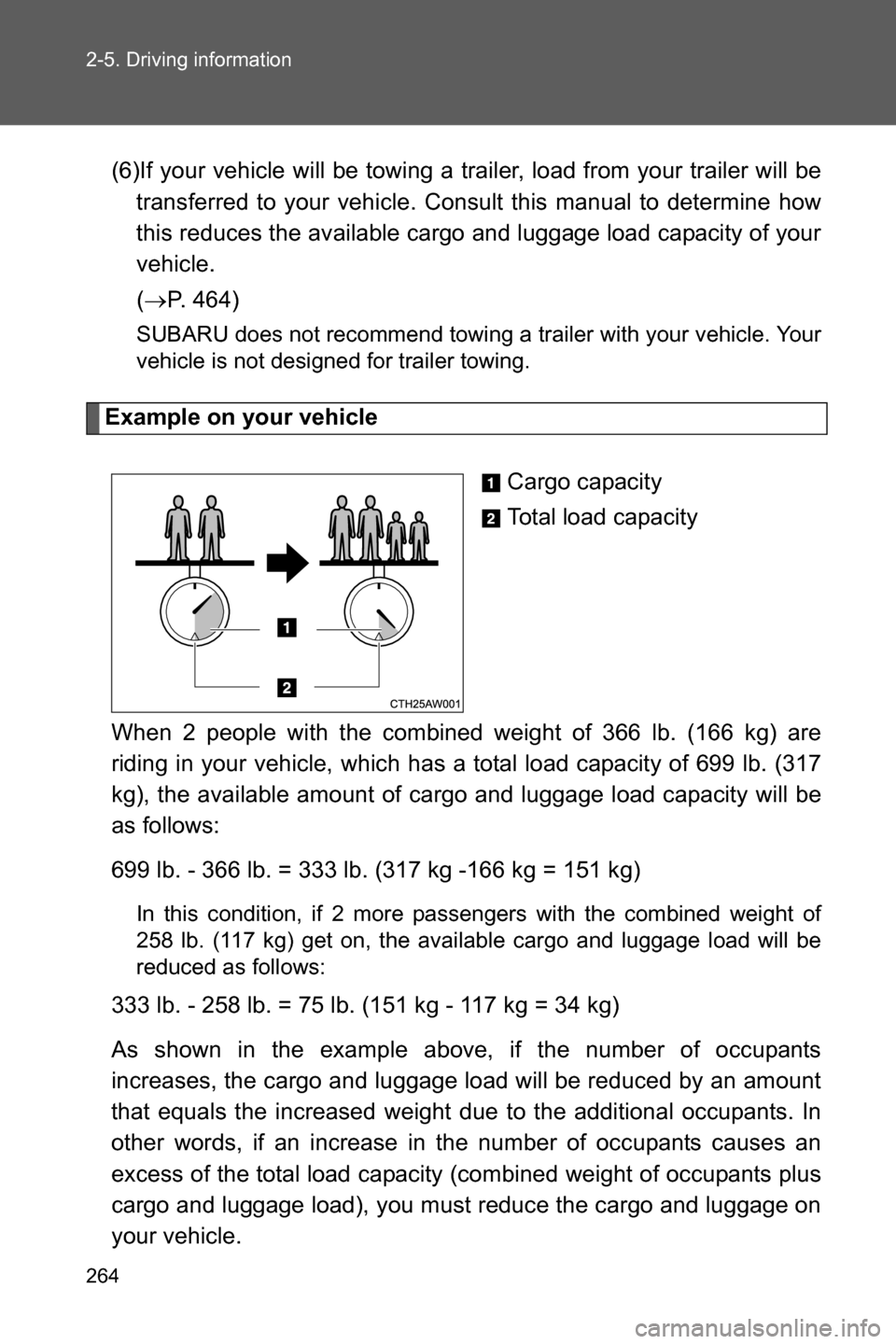
264 2-5. Driving information
(6)If your vehicle will be towing a trailer, load from your trailer will be
transferred to your vehicle. Consult this manual to determine how
this reduces the available cargo and luggage load capacity of your
vehicle.
(�oP. 464)
SUBARU does not recommend towing a trailer with your vehicle. Your
vehicle is not designed for trailer towing.
Example on your vehicle
Cargo capacity
To t a l l o a d c a p a c i t y
When 2 people with the combined weight of 366 lb. (166 kg) are
riding in your vehicle, which has a total load capacity of 699 lb. (317
kg), the available amount of cargo and luggage load capacity will be
as follows:
699 lb. - 366 lb. = 333 lb. (317 kg -166 kg = 151 kg)
In this condition, if 2 more passengers with the combined weight of
258 lb. (117 kg) get on, the available cargo and luggage load will be
reduced as follows:
333 lb. - 258 lb. = 75 lb. (151 kg - 117 kg = 34 kg)
As shown in the example above, if the number of occupants
increases, the cargo and luggage load will be reduced by an amount
that equals the increased weight due to the additional occupants. In
other words, if an increase in the number of occupants causes an
excess of the total load capacity (combined weight of occupants plus
cargo and luggage load), you must reduce the cargo and luggage on
your vehicle.
Page 267 of 540
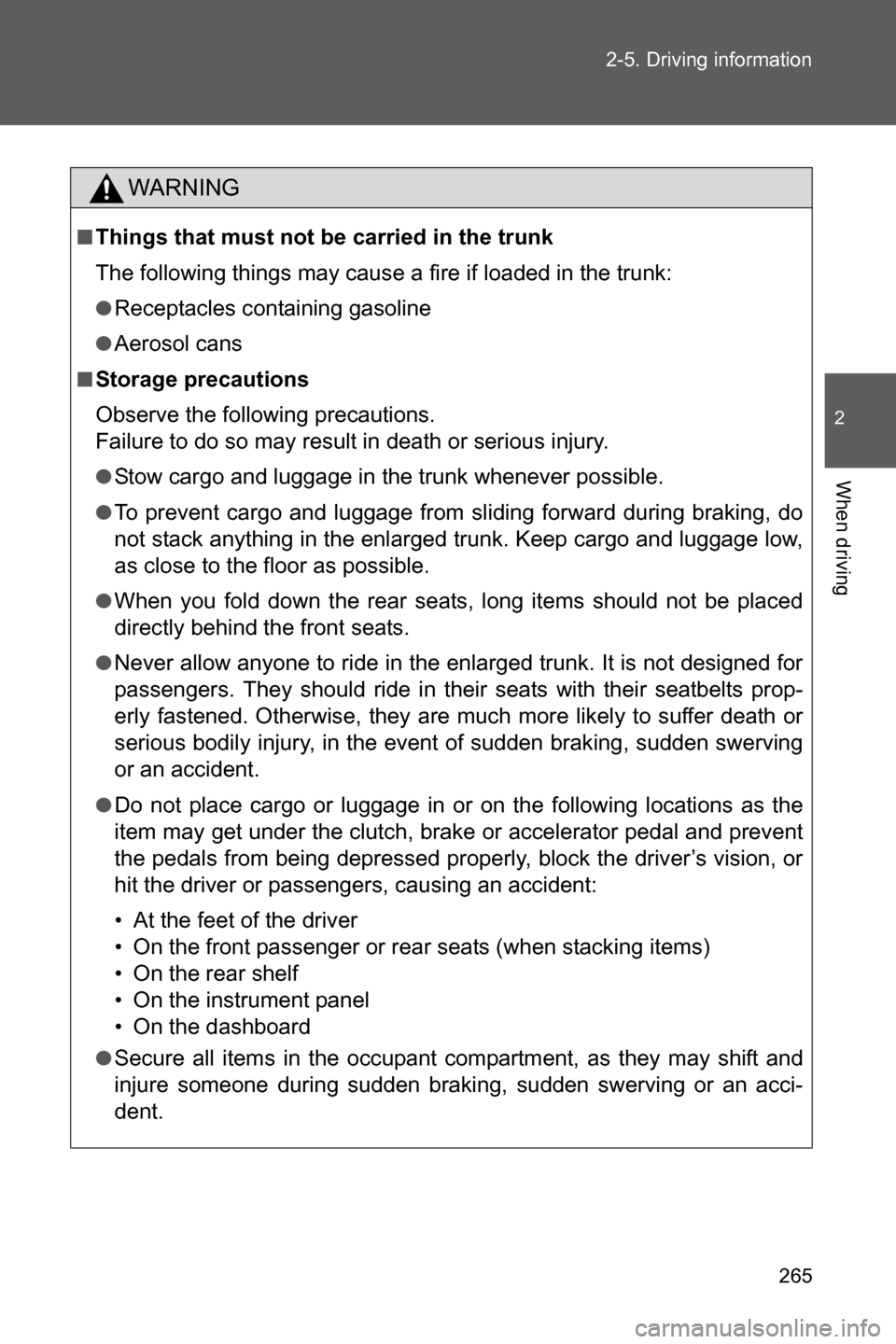
265 2-5. Driving information
2
When driving
WARNING
■Things that must not be carried in the trunk
The following things may cause a fire if loaded in the trunk:
●Receptacles containing gasoline
●Aerosol cans
■Storage precautions
Observe the following precautions.
Failure to do so may result in death or serious injury.
●Stow cargo and luggage in the trunk whenever possible.
●To prevent cargo and luggage from sliding forward during braking, do
not stack anything in the enlarged trunk. Keep cargo and luggage low,
as close to the floor as possible.
●When you fold down the rear seats, long items should not be placed
directly behind the front seats.
●Never allow anyone to ride in the enlarged trunk. It is not designed for
passengers. They should ride in their seats with their seatbelts prop-
erly fastened. Otherwise, they are much more likely to suffer death or
serious bodily injury, in the event of sudden braking, sudden swerving
or an accident.
●Do not place cargo or luggage in or on the following locations as the
item may get under the clutch, brake or accelerator pedal and prevent
the pedals from being depressed properly, block the driver’s vision, or
hit the driver or passengers, causing an accident:
• At the feet of the driver
• On the front passenger or rear seats (when stacking items)
• On the rear shelf
• On the instrument panel
• On the dashboard
●Secure all items in the occupant compartment, as they may shift and
injure someone during sudden braking, sudden swerving or an acci-
dent.
Page 268 of 540

266 2-5. Driving information
WARNING
■Capacity and distribution
●Do not exceed the maximum axle weight rating or the total vehicle
weight rating.
●Even if the total load of occupant's weight and the cargo load is less
than the total load capacity, do not apply the load unevenly. Improper
loading may cause deterioration of steering or braking control which
may cause death or serious injury.
Page 269 of 540
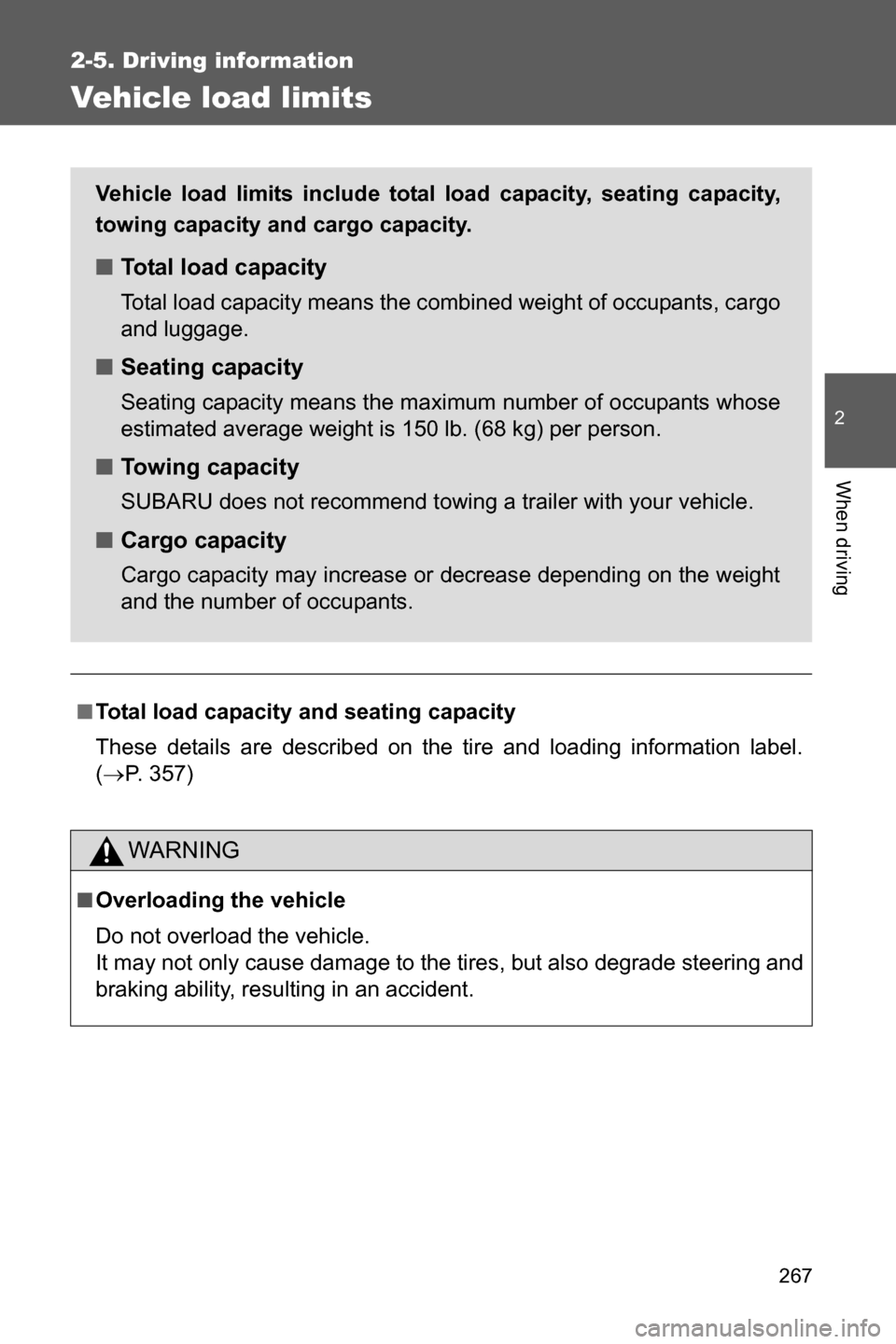
267
2-5. Driving information
2
When driving
Vehicle load limits
■Total load capacity and seating capacity
These details are described on the tire and loading information label.
(�oP. 357)
WARNING
■Overloading the vehicle
Do not overload the vehicle.
It may not only cause damage to the tires, but also degrade steering and
braking ability, resulting in an accident.
Vehicle load limits include total load capacity, seating capacity,
towing capacity and cargo capacity.
■Total load capacity
Total load capacity means the combined weight of occupants, cargo
and luggage.
■Seating capacity
Seating capacity means the maximum number of occupants whose
estimated average weight is 150 lb. (68 kg) per person.
■Towing capacity
SUBARU does not recommend towing a trailer with your vehicle.
■Cargo capacity
Cargo capacity may increase or decrease depending on the weight
and the number of occupants.
Page 270 of 540
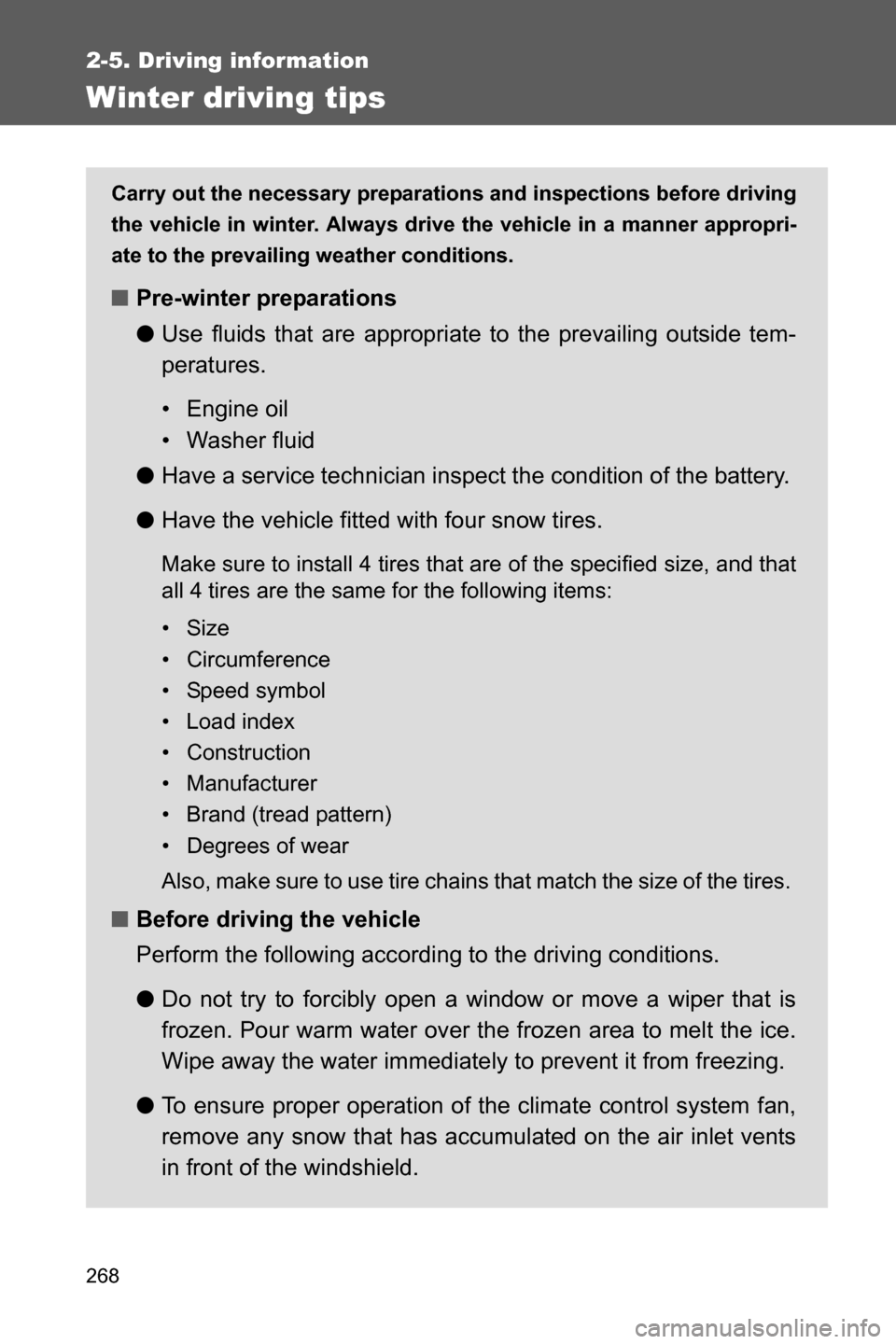
268
2-5. Driving information
Winter driving tips
Carry out the necessary preparations and inspections before driving
the vehicle in winter. Always drive the vehicle in a manner appropri-
ate to the prevailing weather conditions.
■Pre-winter preparations
●Use fluids that are appropriate to the prevailing outside tem-
peratures.
• Engine oil
• Washer fluid
●Have a service technician inspect the condition of the battery.
●Have the vehicle fitted with four snow tires.
Make sure to install 4 tires that are of the specified size, and that
all 4 tires are the same for the following items:
•Size
• Circumference
• Speed symbol
• Load index
• Construction
• Manufacturer
• Brand (tread pattern)
• Degrees of wear
Also, make sure to use tire chains that match the size of the tires.
■Before driving the vehicle
Perform the following according to the driving conditions.
●Do not try to forcibly open a window or move a wiper that is
frozen. Pour warm water over the frozen area to melt the ice.
Wipe away the water immediately to prevent it from freezing.
●To ensure proper operation of the climate control system fan,
remove any snow that has accumulated on the air inlet vents
in front of the windshield.